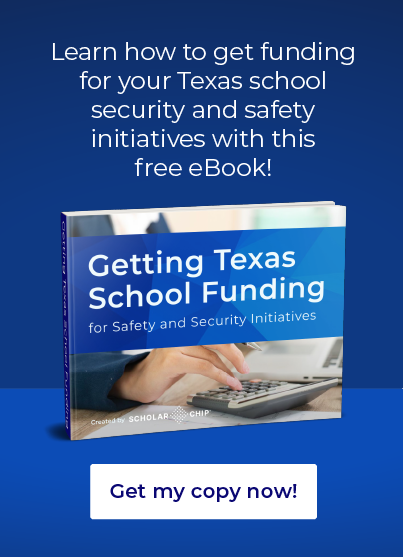Texas is among the many states that have had to face the harsh reality of violence in its schools. After the shooting at Santa Fe High School, the state’s lawmakers have sought ways to come to terms with this and other concerns around school violence. With an eye on preventing future shootings and improving overall security and student and teacher well-being, the Texas legislature in 2019 passed laws that set guidelines and expectations for districts across the state.
While these laws include language that makes it clear that prevention and mental health programs are as important as infrastructure and physical security hardening initiatives, the funding allocated for school safety programs fell short of reflecting that message. In all, the Texas legislature set aside $100M for building and grounds improvements. The funds were earmarked for adding metal detectors, adding or upgrading fencing, and installing bullet-resistant glass to school entrances.
This doesn’t mean, however, that Texas schools don’t have access to funds for other important prevention activities. There are options for administrators and districts looking to add broader safety initiatives than simply adding physical and reactive measures. Grants, for instance, have become an essential element in funding initiatives that result in safer schools in many states.
3 Tips for Texas Public School Funding for Safety Initiatives
Access to those grants, however, means taking a broader perspective on what building a safe environment entails. The good news is that alternative safety initiatives are backed by research showing their effectiveness in improving school climate.
Consider Funding Options for Mental Health Programs
Mental health management can be a crucial component in improving student safety and school environments. The recent Texas laws specifically acknowledge the need for expanded mental health programs, but these should do more than provide counseling after an event. Proactive mental health programs can help improve school climate and consequently, improve safety.
Funding for programs for intervention and for students in need of additional emotional and behavioral support are becoming more widely available as recognition of the need for such services expands.
These Texas public school funding opportunities have several different focuses, and schools should look for grants that will best serve their student and staff population. For example, programs like Project Prevent are geared at helping students deal with violence in their communities, and the Mental Health Demonstration Grant Program is intended to encourage training for mental health providers within a school.
Add in Preventative Programs and Initiatives
Safety initiatives should include programs that improve the school climate and student experience. One proven method for improving student outcomes and lowering behavior challenges is by implementing Social Emotional Learning (SEL) programs.
SEL programs teach students goal setting and achievement, emotional self-management, empathy, responsible decision-making, and how to build and maintain positive relationships. By providing students with the tools to deal with the stress of school and life, the evidence-based practices that are part of an SEL program involve students in their own growth and success and encourage them to care about those around them. This promotes a more welcoming school environment and an atmosphere that encourages positive interactions.
Research has shown that violence goes down in schools where student achievement is high. Because of this, funding and grants for implementing an SEL program are, in essence, an investment in school safety.
Think Beyond Hardening
Reducing violence and having a better overall school environment go hand in hand. A positive environment in which students feel safe promotes better academic performance and student outcomes, which, in turn, reduces violence.
For students to feel safe in their classrooms and perform well, they must be present and student behavior must be appropriate. Attendance and behavioral issues can be indicators of larger or growing problems on campus. For instance, chronic absences can cause students to struggle in their classwork, which can cause them to act out. Attendance issues can also be a signifier of bullying.
Catching and addressing problems like bullying or poor classroom behavior lets schools correct course and prevent underlying issues from blooming into delinquency and violence. To do this, however, administrators and staff need the right tools that track and report problems in a way that doesn’t disrupt the school day or take valuable time away from lessons.
Technology solutions for attendance and behavior management make recording, tracking, and reporting accurate and non-intrusive. These systems improve student outcomes and promote a positive school climate, while also being preventative measures to violence and delinquency. Certain school technology grants allow for upgrading and adding to administrative systems. Schools can use these grants to add attendance tracking and behavior monitoring applications into their systems as a long-term solution and commitment to school safety.
While the 2019-2020 allocation of $100M for school safety programs may focus on physical security measures, that doesn’t mean Texas public school funding is without options. Not only does the wording of the recent laws include references to more preventative strategies and proactive programs, like mental health support, but funding for these programs can also come from other sources. Grants intended for initiatives like SEL and technology implementations support proven programs that prevent violence and promote a positive school culture. These proactive strategies create a better learning environment, which, in turn, results in students who are more successful both in school and in life.
ScholarChip offers a solution called Alternative Behavior Educator (ABE). This innovative program enables school administrators and counselors to identify, monitor, and improve student behavior throughout a student’s career, while giving them powerful data-driven reports that quickly flag at-risk students, help monitor and chronicle progress, and help them identify school safety risks before incidents.
To learn how ScholarChip can help make Texas schools safer or get free recommendations, feel free to contact us for a free consultation!


